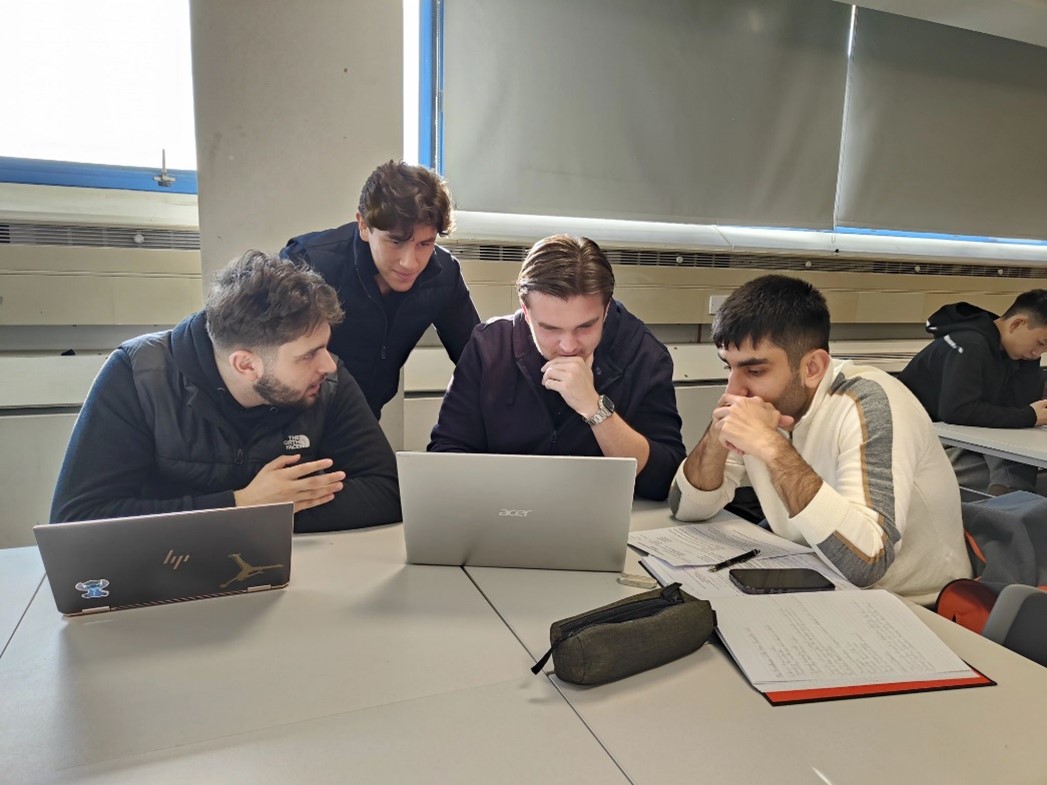Employability in the Undergraduate Curriculum: Co-Creating with AI for Decision-Making in Business Simulation

As part of an initiative to enhance students’ employability skills and graduate attributes on the BSc Business Management Programme, we have incorporated experiential learning into the Year 3 module BUS371 Strategic Analysis and Practice. This aims to enhance the development of graduate attributes including AI literacy, decision-making, teamwork, and critical thinking through the use of a business simulation.
Responding to a need
The use of simulation is designed to enhance employability and career outcomes, with a particular focus on improving students' AI literacy to address the growing demands of an evolving job market (Atsmon, 2023).
By co-creating with AI in decision-making, students gain hands-on experience in applying AI tools to business scenarios. In this simulation, students work alongside AI systems to analyse data, make strategic decisions, and assess outcomes, allowing them to develop both technical skills and critical thinking abilities.
This process not only enhances their understanding of how AI can support decision-making but also boosts their employability by equipping them with the skills needed in industries increasingly reliant on AI technologies. As students engage in simulated business environments, they also strengthen other key graduate attributes such as problem-solving, teamwork, and adaptability which are essential skills for career success in an AI-driven world (Times Higher Education, 2021).
Given that low attendance is a common issue faced by many UK institutions, the use of simulations has been shown to significantly boost in-class participation, fostering a more interactive and dynamic learning environment (Pinter et al., 2020).
Approach used
Students work in groups, taking on the role of owners of a smartphone company. Although the company does not produce smartphones itself, the owners must make crucial decisions, such as setting quality standards and determining the features developed by the in-house R&D department.
By linking theoretical concepts with practical decision-making, students are required to analyse the business environment and the company’s performance to make a series of strategic decisions, including those related to the company’s competitive strategy, market entry countries, marketing, finance, and HR.
The simulation spans seven weeks, including two rounds of trial sessions. The activities and tasks are directly aligned with the module learning outcomes and the summative assessment, where students are required to reflect on their simulation experience and explain how they applied relevant theories and frameworks in a controlled environment to make decisions. In addition, they must evaluate and critically reflect on the outcomes of those decisions.
As part of their reflective report, students must link the strategies and frameworks employed during the simulation to real-world business contexts. They are also required to assess their personal development, providing insights into the skills and knowledge gained throughout the simulation.
The design approach incorporates five key milestones and multifaceted stages to ensure the successful integration of the simulation into the module.
Preparation and Orientation: In Week 1, the simulation is introduced to students, accompanied by a comprehensive support pack that includes instructional videos and a user manual. During this session, students are briefed on the importance of active participation in the simulation and its direct connection to the summative assessment.
Students are also given class time to form groups of five and discuss their plans for collaboration. This group formation and initial discussion aim to establish clear expectations, foster effective teamwork, and encourage a shared commitment to the simulation activities from the outset.
Tool Familiarisation: In Week 2, the module organiser informs students about their access to Microsoft Copilot through their university email accounts. This announcement ensures that all students are aware of the available AI tools and promotes inclusivity in accessing these resources.
To further support students, the module organiser has created a detailed, step-by-step instructional guide with visuals to help them set up their accounts and gain access to Microsoft Copilot.
AI Integration: During the trial rounds of the simulation in Weeks 3 and 4, students are encouraged to leverage various AI tools to enhance their creativity and strategic thinking. For example, they use these tools to generate ideas for their company’s mission and vision statements, design a logo, and conduct a SWOT analysis.
Between Weeks 5 and 8, student teams actively run their smartphone businesses and are encouraged to leverage AI for brainstorming, such as seeking problem-solving suggestions. For example, they might use AI to generate solutions for challenges like addressing company losses.
This hands-on engagement with AI tools is designed to enhance their learning experience while fostering innovation, problem-solving, and decision-making.
Co-creation with AI: In Week 8, students start to co-create with AI by using the company performance data provided by the simulation to create effective prompts and find strategic solutions. They are encouraged to use different AI tools, such as ChatGPT and Microsoft Copilot, to compare the outcomes generated from various prompts.
In addition, they are challenged with critical questions such as: ‘Are AI responses valid and helpful?’, ‘What problems do you face with AI-generated solutions?’, and ‘How can your group use the suggestions from AI effectively?’.
These reflective questions encourage students to think critically about the value of AI-generated insights and help them evaluate AI responses. By engaging with these questions, students deepen their understanding of AI’s capabilities, limitations and ethical implications, thereby enhancing their AI literacy and developing the skills necessary for effectively integrating AI in business decision-making.
Reflection and Assessment: Students are encouraged to reflect weekly on the outcomes of the strategic decisions made with AI. This reflection aims to improve their ability to write better and more accurate prompts while exploring different ways to use AI tools more effectively. By engaging in this process, students refine their skills in AI interaction and decision-making.
In the final individual reflective report, students are required to reflect on their personal development. This assessment also allows students to demonstrate how AI tools have contributed to their learning process and the enhancement of their strategic decision-making skills. This reflection not only encourages self-assessment but also reinforces the value of AI as a learning tool in the context of business strategy.
Impact
In evaluating the impact of this intervention, we have found that simulations offer a more engaging and interactive learning environment compared to traditional activities, such as case studies, commonly used in strategic management modules. This hands-on approach fosters deeper involvement, making learning more tangible and enjoyable. Consequently, the module consistently achieves a strong level of attendance throughout the semester (from week 1 to week 10), averaging 60% across five weekly workshop groups.
Notably, students have indicated via the module experience survey that the simulation has significantly contributed to the development of their collaboration and teamwork skills. They mention working together in groups to make decisions and explain their rationale has fostered stronger communication and cooperative decision-making abilities.
In addition, students have provided feedback that the use of AI and the simulation has helped them to develop organisational and analytical skills. By evaluating various strategic decisions, they feel better equipped to manage complex tasks, which enhances their overall problem-solving capabilities.
Students also appreciate the application of theoretical concepts and frameworks through this game-based learning method with many finding it enjoyable. One student commented: ‘I would like if we could run the simulation for a longer time period as it is extremely fun to engage with’, while another shared: ‘I enjoy the different learning approach using the simulation as it gives us a perspective on how to manage a company’. These reflections highlight how the simulation offers a hands-on, interactive approach to understanding real-world business management.
“The group activities were a good way to implement what we had done in the lecture on the simulation”.— QMUL Student
Recommendations
When implementing a simulation-based learning approach, especially one that incorporates AI tools, educators should consider several important barriers and best practices to enhance the effectiveness of the learning experience:
- As students come with varied levels of digital skills, it is important to ensure that all participants are comfortable using AI tools and the simulation platform. Educators should provide support materials, tutorials, and additional resources to address different levels of proficiency.
- Demonstrating patience and consistently guiding students through the use of the simulation platform and AI tools is vital for helping them familiarise themselves with new technology and minimising resistance, such as pushback against using new technology in learning.
- Educators need to be well-versed in the platform and tools being used and provide consistent instructions, especially for large modules, involving multiple tutors.
- Group dynamics can be challenging, especially for students who need to work or have caring responsibilities. It is important to consistently remind students of the importance of communication, inclusivity, and shared responsibility in group work. The module organiser needs to be supportive and prepared to answer many questions from students regarding the simulation.
- Finally, connecting the simulation experience to theoretical concepts is another challenge, particularly for students from diverse disciplinary backgrounds, such as law and business management, who may not have a deep understanding of business and strategy knowledge. Therefore, the use of scaffolding methods is useful. For example, prepare students with the materials needed before integrating any AI tools and encourage them to co-create with AI on low-stakes tasks, such as creating company logos, before moving on to higher-stakes tasks, such as analysis and creation. In addition, encouraging students to complete pre-session readings and build on their understanding can make it easier to help them connect the simulation experience to theoretical concepts.
In the context of business education, we have found that experiential learning methods are an effective approach to enhancing student learning. Not only do they bring theoretical concepts to life and increase student engagement, but they also develop key skills and graduate attributes, enhancing students’ employability.
"I really enjoyed the phone venture simulation. It has been my absolute favourite activity in a seminar of my 3 years in Queen Mary. It is a fun way to use class concepts and apply them to the simulation alongside working with group"— QMUL Student
References:
Atsmon, Y. (2023). Artificial intelligence in strategy. Available at: https://www.mckinsey.com/~/media/mckinsey/business%20functions/strategy%20and%20corporate%20finance/our%20insights/artificial%20intelligence%20in%20strategy/artificial-intelligence-in-strategy.pdf?shouldIndex=false [Accessed 20 Nov. 2024].
Times Higher Education (2021). Digital literacy in the UK: The consultancy report. Available at: https://www.timeshighereducation.com/sites/default/files/digital_literacy_in_the_uk_the_consultancy_report.pdf [Accessed 15 Nov. 2024].
Pinter, R., Cisar, S.M., Balogh, Z. and Manojlovic, H. (2020). 'Enhancing higher education student class attendance through gamification,' Acta Polytechnica Hungarica, 17(2), pp. 13–33. https://doi.org/10.12700/aph.17.2.2020.2.2.
No such formatter
